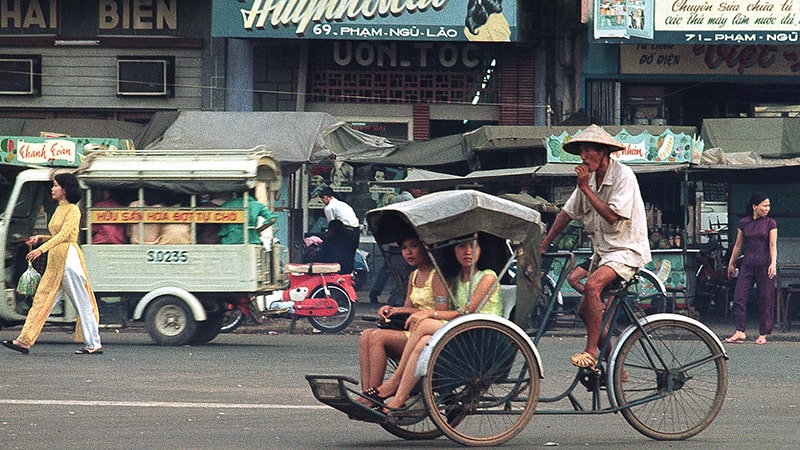Welcome to VNAround (vnaround.com) – more than a blog, we’re your Viet guide to uncovering Vietnam’s cultural and historical treasures. Today, let’s dive into the story of xe xích lô, Vietnam’s iconic pedicab. This mode of transportation is not just a relic of the past but a symbol of Vietnam’s resilience, culture, and history.
What is Xe Xích Lô?
Definition and Design
Xe xích lô, also known simply as xích lô or cyclo, is a three-wheeled pedicab. It features a front passenger seat with a canopy and a rear bicycle mechanism operated by a driver.
Purpose
Initially designed as a means of transportation, xe xích lô has evolved into a nostalgic experience for tourists and a symbol of traditional Vietnamese life.
Origins of Xe Xích Lô

French Influence
The xe xích lô traces its origins to the colonial French era in Vietnam during the late 19th and early 20th centuries. Inspired by the rickshaw, which was popular in China and Japan, the French introduced the cyclo as a more comfortable alternative.
Early Adoption
By the 1930s, xe xích lô had become a common sight in cities like Hanoi, Saigon (now Ho Chi Minh City), and Hue. It was used to transport both locals and French colonial officials.
Xe Xích Lô During the War Era
World War II and Beyond
During World War II and the subsequent Indochina and Vietnam Wars, xe xích lô remained a practical mode of transport. Its simplicity and fuel-free operation made it indispensable during times of fuel shortages.
Cultural Significance
Xe xích lô became a symbol of resilience as drivers, known as “cyclists,” supported their families by transporting goods, people, and even military supplies in some cases.
Modern Era: From Necessity to Nostalgia
Decline in Usage
With the advent of motorbikes, cars, and buses, xe xích lô gradually lost its place as a primary means of transportation. However, it found a new life catering to tourists seeking an authentic Vietnamese experience.
Cultural Preservation
Today, xe xích lô is a beloved cultural icon. Many cities, such as Hanoi and Ho Chi Minh City, offer cyclo tours, allowing visitors to explore historical landmarks and bustling streets from a unique perspective.
Significance of Xe Xích Lô Today
A Living Tradition
Xe xích lô continues to represent Vietnam’s rich cultural heritage. It’s often featured in festivals, parades, and movies, symbolizing the simplicity and warmth of Vietnamese life.
Tourist Attraction
For travelers, xe xích lô rides are more than just transportation—they’re an opportunity to connect with local culture, hear stories from drivers, and enjoy a leisurely view of Vietnam’s vibrant cities.
Tips for Enjoying a Xe Xích Lô Ride
- Negotiate the Price: Always agree on a price before starting your ride.
- Choose Licensed Operators: Look for official xe xích lô operators to ensure safety and fair pricing.
- Best Places for Cyclo Rides: The Old Quarter in Hanoi, Hue’s Imperial City, and Ho Chi Minh City’s Ben Thanh Market area are great spots for a ride.
At VNAround (vnaround.com), we love sharing the stories behind Vietnam’s traditions. The xe xích lô is more than a pedicab—it’s a testament to Vietnam’s adaptability, cultural pride, and timeless charm. Whether you’re a history enthusiast or a curious traveler, a cyclo ride offers a memorable glimpse into Vietnam’s past and present.
Resources
- French Colonial Influence on Vietnamese Transport – Britannica – https://www.britannica.com/vietnam-history
- Cyclo Tours in Vietnam – Culture Trip – https://theculturetrip.com/vietnam/cyclo-tours
Let us know if you’ve experienced a xe xích lô ride, and stay tuned to VNAround for more insights into Vietnam’s history and culture! 🌏



